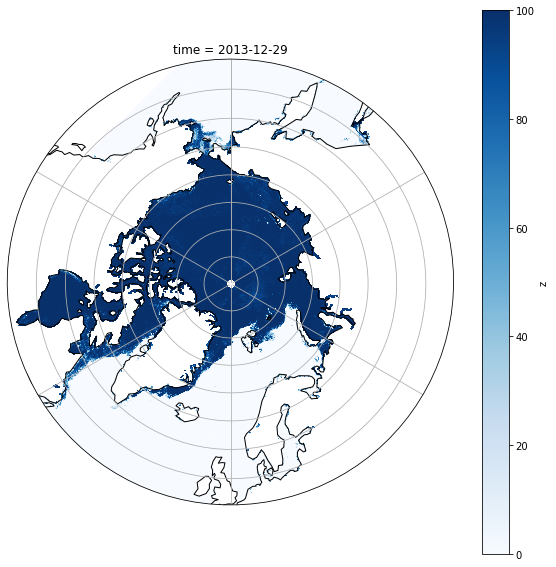MODIS Sea-ice
Contents
MODIS Sea-ice¶
import xarray as xr
xr.set_options(display_style='html')
import cftime
import matplotlib.pyplot as plt
import matplotlib.path as mpath
import cartopy.crs as ccrs
from cmcrameri import cm
import pandas as pd
import numpy as np
%matplotlib inline
import s3fs
Satellite (MODIS)¶
fs = s3fs.S3FileSystem(anon=False,
client_kwargs={'endpoint_url': 'https://forces2021.uiogeo-apps.sigma2.no/'})
#Choose the year to load satellite data (2012-2019)
i = 2013
#Satellite data
s3path = 's3://data/ASMR2/seaiceconc/'+str(i)+'/*.nc'
print('Reading sea ice concentration from year '+str(i))
remote_files = fs.glob(s3path)
fileset = [fs.open(file) for file in remote_files]
d2019 = xr.open_mfdataset(fileset, combine='nested',concat_dim=['time'])
d2019['time'] = pd.to_datetime(list(map(lambda x: x[43:51],remote_files)))
Reading sea ice concentration from year 2013
d2019.polar_stereographic
<xarray.DataArray 'polar_stereographic' (time: 239)>
array([b'', b'', b'', b'', b'', b'', b'', b'', b'', b'', b'', b'', b'',
b'', b'', b'', b'', b'', b'', b'', b'', b'', b'', b'', b'', b'',
b'', b'', b'', b'', b'', b'', b'', b'', b'', b'', b'', b'', b'',
b'', b'', b'', b'', b'', b'', b'', b'', b'', b'', b'', b'', b'',
b'', b'', b'', b'', b'', b'', b'', b'', b'', b'', b'', b'', b'',
b'', b'', b'', b'', b'', b'', b'', b'', b'', b'', b'', b'', b'',
b'', b'', b'', b'', b'', b'', b'', b'', b'', b'', b'', b'', b'',
b'', b'', b'', b'', b'', b'', b'', b'', b'', b'', b'', b'', b'',
b'', b'', b'', b'', b'', b'', b'', b'', b'', b'', b'', b'', b'',
b'', b'', b'', b'', b'', b'', b'', b'', b'', b'', b'', b'', b'',
b'', b'', b'', b'', b'', b'', b'', b'', b'', b'', b'', b'', b'',
b'', b'', b'', b'', b'', b'', b'', b'', b'', b'', b'', b'', b'',
b'', b'', b'', b'', b'', b'', b'', b'', b'', b'', b'', b'', b'',
b'', b'', b'', b'', b'', b'', b'', b'', b'', b'', b'', b'', b'',
b'', b'', b'', b'', b'', b'', b'', b'', b'', b'', b'', b'', b'',
b'', b'', b'', b'', b'', b'', b'', b'', b'', b'', b'', b'', b'',
b'', b'', b'', b'', b'', b'', b'', b'', b'', b'', b'', b'', b'',
b'', b'', b'', b'', b'', b'', b'', b'', b'', b'', b'', b'', b'',
b'', b'', b'', b'', b''], dtype='|S1')
Coordinates:
* time (time) datetime64[ns] 2013-01-01 2013-01-02 ... 2013-12-31
Attributes:
grid_mapping_name: polar_stereographic
straight_vertical_longitude_from_pole: [-45.]
false_easting: [0.]
false_northing: [0.]
latitude_of_projection_origin: [90.]
standard_parallel: [70.]
long_name: CRS definition
longitude_of_prime_meridian: [0.]
semi_major_axis: [6378273.]
inverse_flattening: [298.27941112]
spatial_ref: PROJCS["NSIDC Sea Ice Polar Stere...
GeoTransform: -3850000 6250 0 5850000 0 -6250 xarray.DataArray
'polar_stereographic'
- time: 239
- b'' b'' b'' b'' b'' b'' b'' b'' ... b'' b'' b'' b'' b'' b'' b'' b''
array([b'', b'', b'', b'', b'', b'', b'', b'', b'', b'', b'', b'', b'', b'', b'', b'', b'', b'', b'', b'', b'', b'', b'', b'', b'', b'', b'', b'', b'', b'', b'', b'', b'', b'', b'', b'', b'', b'', b'', b'', b'', b'', b'', b'', b'', b'', b'', b'', b'', b'', b'', b'', b'', b'', b'', b'', b'', b'', b'', b'', b'', b'', b'', b'', b'', b'', b'', b'', b'', b'', b'', b'', b'', b'', b'', b'', b'', b'', b'', b'', b'', b'', b'', b'', b'', b'', b'', b'', b'', b'', b'', b'', b'', b'', b'', b'', b'', b'', b'', b'', b'', b'', b'', b'', b'', b'', b'', b'', b'', b'', b'', b'', b'', b'', b'', b'', b'', b'', b'', b'', b'', b'', b'', b'', b'', b'', b'', b'', b'', b'', b'', b'', b'', b'', b'', b'', b'', b'', b'', b'', b'', b'', b'', b'', b'', b'', b'', b'', b'', b'', b'', b'', b'', b'', b'', b'', b'', b'', b'', b'', b'', b'', b'', b'', b'', b'', b'', b'', b'', b'', b'', b'', b'', b'', b'', b'', b'', b'', b'', b'', b'', b'', b'', b'', b'', b'', b'', b'', b'', b'', b'', b'', b'', b'', b'', b'', b'', b'', b'', b'', b'', b'', b'', b'', b'', b'', b'', b'', b'', b'', b'', b'', b'', b'', b'', b'', b'', b'', b'', b'', b'', b'', b'', b'', b'', b'', b'', b'', b'', b'', b'', b'', b'', b'', b'', b'', b'', b'', b''], dtype='|S1') - time(time)datetime64[ns]2013-01-01 ... 2013-12-31
array(['2013-01-01T00:00:00.000000000', '2013-01-02T00:00:00.000000000', '2013-01-03T00:00:00.000000000', ..., '2013-12-29T00:00:00.000000000', '2013-12-30T00:00:00.000000000', '2013-12-31T00:00:00.000000000'], dtype='datetime64[ns]')
- grid_mapping_name :
- polar_stereographic
- straight_vertical_longitude_from_pole :
- [-45.]
- false_easting :
- [0.]
- false_northing :
- [0.]
- latitude_of_projection_origin :
- [90.]
- standard_parallel :
- [70.]
- long_name :
- CRS definition
- longitude_of_prime_meridian :
- [0.]
- semi_major_axis :
- [6378273.]
- inverse_flattening :
- [298.27941112]
- spatial_ref :
- PROJCS["NSIDC Sea Ice Polar Stereographic North",GEOGCS["Unspecified datum based upon the Hughes 1980 ellipsoid",DATUM["Not_specified_based_on_Hughes_1980_ellipsoid",SPHEROID["Hughes 1980",6378273,298.279411123064,AUTHORITY["EPSG","7058"]],AUTHORITY["EPSG","6054"]],PRIMEM["Greenwich",0,AUTHORITY["EPSG","8901"]],UNIT["degree",0.0174532925199433,AUTHORITY["EPSG","9122"]],AUTHORITY["EPSG","4054"]],PROJECTION["Polar_Stereographic"],PARAMETER["latitude_of_origin",70],PARAMETER["central_meridian",-45],PARAMETER["scale_factor",1],PARAMETER["false_easting",0],PARAMETER["false_northing",0],UNIT["metre",1,AUTHORITY["EPSG","9001"]],AXIS["X",EAST],AXIS["Y",NORTH],AUTHORITY["EPSG","3411"]]
- GeoTransform :
- -3850000 6250 0 5850000 0 -6250
Plotting one date¶
def polarCentral_set_latlim(lat_lims, ax):
ax.set_extent([-180, 180, lat_lims[0], lat_lims[1]], ccrs.PlateCarree())
# Compute a circle in axes coordinates, which we can use as a boundary
# for the map. We can pan/zoom as much as we like - the boundary will be
# permanently circular.
theta = np.linspace(0, 2*np.pi, 100)
center, radius = [0.5, 0.5], 0.5
verts = np.vstack([np.sin(theta), np.cos(theta)]).T
circle = mpath.Path(verts * radius + center)
ax.set_boundary(circle, transform=ax.transAxes)
fig = plt.figure(1, figsize=[10,10])
# Fix extent
minval = 0
maxval = 100.
ax = plt.subplot(1, 1, 1, projection=ccrs.NorthPolarStereo())
ax.coastlines()
ax.gridlines()
polarCentral_set_latlim([50,90], ax)
d2019.z.sel(time='2013.12.29').plot(ax=ax, vmin=minval, vmax=maxval, transform=ccrs.NorthPolarStereo(central_longitude=-45, true_scale_latitude=70), cmap='Blues')
<matplotlib.collections.QuadMesh at 0x7f6084afe430>

